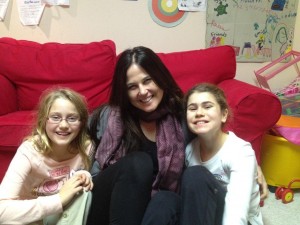From Our Clinical Director: The Top Ten Features of Family-Centred Practice

Clinical Director Tina Linton with her friends Lindsay (right) and Nicole (left). Tina has been working with Lindsay and her family since Lindsay was 3 years old. Nicole is Lindsay’s sister.
I am excited to have the opportunity to reach out to you all via our new blog. From time to time, I will be writing to you personally, in addition to our blog on behalf of the group.
I am fortunate to meet so many lovely families in my role as Clinical Director of Family Centred Practices Group. One of the questions families typically ask me is, “Why should we choose your program for our child and family?”
When explaining to families the many benefits of working with our group, I often emphasize that one of the reasons is in our name , Family Centred Practices Group. Working closely with families is one of the key components of best practice in Applied Behaviour Analysis-based intervention programs. I review other components of best practice with parents and discuss how we at FCPG follow these practices in our work with children and families. I relay the benefit of working with a group of collaborative professionals and having many minds joining to ensure we are current in our field and working together in support of our families. The next question I often get is, “What does it mean to be family-centred?”
I am honoured that I have been asked to speak on this topic as a keynote presenter to early interventionists, educators, parents and government officials in Nova Scotia next month. My talk is called “Effective Practices in Family-Centred Early Intervention.” As I am preparing my presentation, I will share with you some of the information I will be discussing that I hope you will find interesting.
The talk will be based on a number of articles and books that form the body of literature on family-centred practices.
There are many theories that inform what has come to be known as family-centred practice. One article that outlines this is, “Capacity- Building Family-Systems Intervention Practices,”** which was published by Carl Dunst and Carol Trivette in 2009. What follows are some key points based on the theories outlined in that article and others:
- Family-centred intervention should work to build the capacity of the family to support one another. Intervention includes the whole family, not just the child.
- The success of intervention relies heavily on the involvement of the parents.
- Support from professionals for all members of the family is key.
- Intervention should be based around the family’s and child’s strengths, not only their areas of need.
- Intervention should consider the child and family in relation to the larger social systems of which they are a part (e.g., family > neighbourhood > area > city > province > country)
- Intervention should emphasize family empowerment, meaning giving members a sense of control and mastery.
- Intervention should be based on the goals and priorities of the family, not only those chosen by professionals.
- Intervention programs should advocate for the family to turn to their friends, extended family, neighbours, and community so they know they are cared for and helped by others, and that they are part of a supportive social network.
- Intervention should augment the family’s connection to one another (e.g. commitment, appreciation, affection, positive communication, quality time) and their ability to cope with stress and crisis.
- Professionals should follow the principles of help-giving when interacting with families.
“Help-gving” involves more than just offering assistance to someone. We’ll break down the concept in more detail next week. Stay tuned!
** Dunst, C., & Trivette, C. (2009). Capacity-building family-systems intervention practices. Journal of Family Social Work, 12(2), 119-143. A link to the full text of the article is available here.
